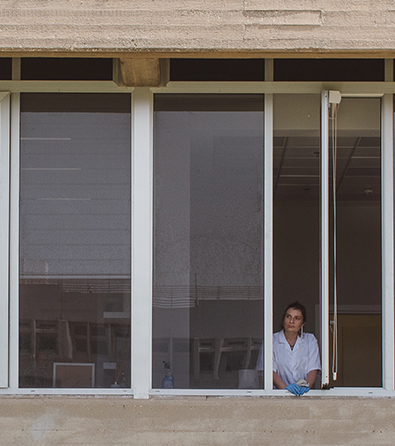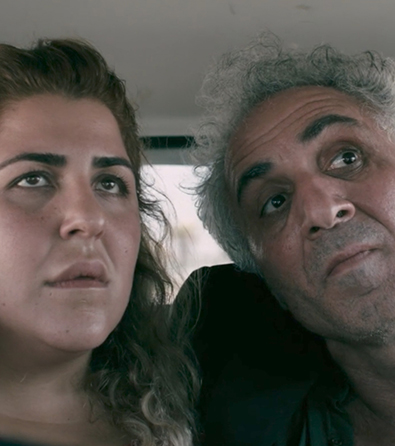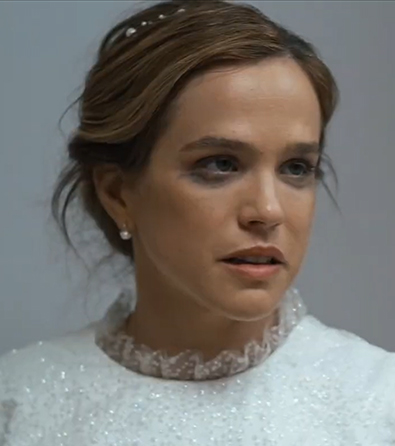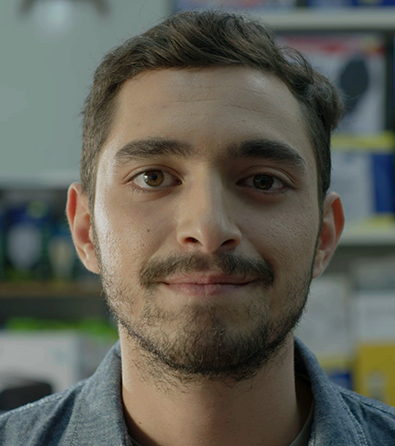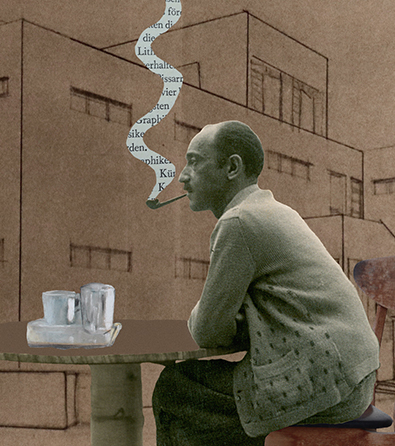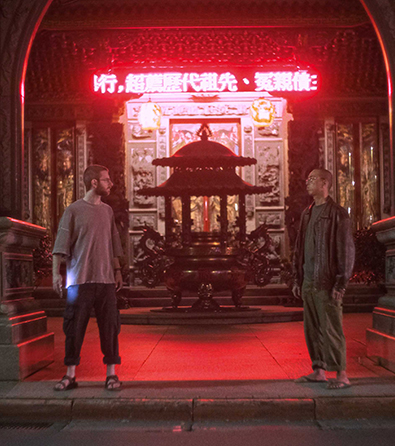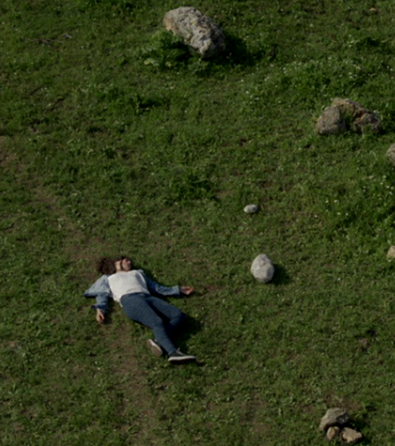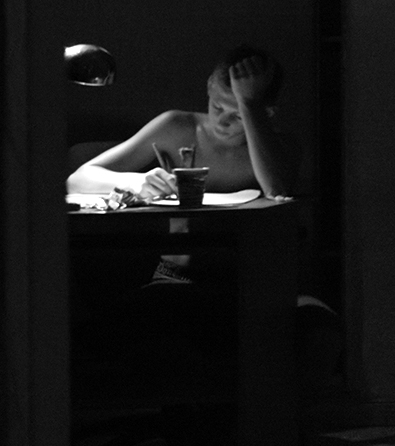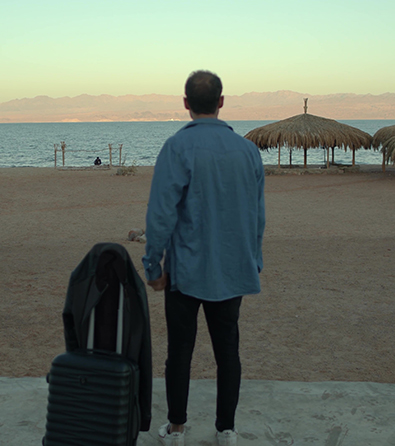The short animated film Holy Holocaust (17:25 minutes) is available at the top of the page.
* To watch this film, please approve YouTube/Vimeo cookies via the blue cookie icon at the bottom left of the screen.
Holy Holocaust, a short animated film by Noa Berman-Herzberg and Osi Wald, is a distinctive cinematic work within the landscape of Holocaust memorial representation. The film is not a direct testimony and does not aim to depict or reconstruct the Holocaust. Instead, it functions as a space of visual dialogue, where narrative, image, and silence coexist, guiding the viewer toward a renewed interpretation of identity, history, and otherness.
From its aesthetic foundation, the film signals its deliberate departure from conventional modes of Holocaust representation, forgoing somber drama and rigid realism in favor of colorful, fantastical animation, grounded in a continuous movement between layers of consciousness, memory, and fantasy. The imagery does not imitate reality but instead seeks to access what Martin Buber, in his 1923 book “I and Thou,” coined the concept of the between.” This is the realm of existence in which the ‘I’ encounters the ‘Thou,’ and the space between them opens to the mystery of the unknown. Buber’s dialogical philosophy explored the human need to overcome existential solitude, in part through conversation with another person.
At the heart of the film lies an intimate friendship between Noa, a Jewish-Israeli woman, and Jennifer, a Black-German woman. The two engage in open conversations, sharing the existential questions that trouble them. The discovery of a horrifying past, as Jennifer’s lineage includes Nazi ancestors, shakes the foundation of their relationship, though it does not result in a simple rupture. This serves as a living embodiment of Martin Buber’s foundational idea: true dialogue is not dependent on agreement or identification, but on the mutual recognition of the other as an irreducible being.
The choice to use non-realist animation underscores this principle: not a physical representation of events, but an emotional and intuitive expression which, much like Franz Rosenzweig’s approach in “The Star of Redemption” (1919), seeks to recreate the relationships between human beings in a disintegrating world. As Rosenzweig argued, redemption is not the project of abstract reason, but of living speech, the word spoken in a real, face-to-face encounter. Similarly, the film does not attempt to offer a coherent narrative or a moral conclusion but rather invites us to linger in a space where the wound is exposed, yet neither resolved nor reconciled.
The dialogical dimension of the film is expressed not only through its text but also through its structure. It unfolds in the encounters between images, between sound and image, and between words and silences. This structure creates a series of appeals to the viewer, appeals that seek recognition rather than judgment. It recalls Emmanuel Levinas’s call in “Totality and Infinity” (1961) to see in the face of the other an ethical summons that eludes definitive answers. It isthe face speaksand renders possibilities and the genesis of all discourse.” In this context, response becomes an act of listening and recognition.
In Holy Holocaust, the illustrated faces of Noa and Jennifer are drawn with the same delicate, shifting lines, breathing, mutable strokes that suggest the fluidity of identity in contrast to fixed or rigid boundaries. The characters’ identities emerge not from a place of power but from vulnerability. There is no clear hierarchy here between “victim” and “perpetrator,” but rather an embodiment of that intermediate space in which a shared wound, even if born of opposing historical narratives, dictates the conditions of dialogue. Dark humor, at times sharp, echoes throughout the film, yet it too serves as a dialogic tool. It is not used to relieve tension, but to expose it. Much like the poetic irony in the work of Paul Celan, who has been described as writing within language and against it, the humor here points to the limits of discourse and to Noa and Jennifer’s efforts to keep speaking even when words fail.
It is evident that Wald and Berman-Herzberg conceive of the past not as a closed repository of facts but as a living text, open to constant reinterpretation, an approach aligned with Franz Rosenzweig’s hermeneutic view. There is no possibility of a total representation of history, only recurring attempts to encounter it with humility and doubt. The film embodies what both Buber and Rosenzweig, each in their way, articulated: that memory, like dialogue, is always a vital act, not one of dead preservation or paralysis, but of opening the wounds of time to allow for the renewal of meaning. In Holy Holocaust, meaning does not lie in the revelation of historical truth, but in the willingness to remain within the dialogic space, even when it is painful, even when it contradicts.
One of Holy Holocaust’s central contributions to philosophical discourse lies in its dialogic approach to trauma, which gives rise to an ethical conversation that resists closure through simple resolution. In Emmanuel Levinas’s ethical framework, the Other is a height that cannot be surmounted (“Totality and Infinity,” 1961). For Levinas, the encounter with the face of the other does not provide knowledge about them but calls forth moral responsibility, without the possibility of fully grasping the nature of that relationship. Within the context of the film, the characters’ faces, especially in their quiet, fleeting moments of encounter, embody this ethical summons. It cannot be reduced to guilt or simplistic forgiveness, but instead calls for an incomplete moral openness, a continuous ethical engagement that remains unresolved.
Martin Buber, for his part, emphasizes that a true encounter with the other requires relinquishing the view of them as an object. Namely, when I experience another, I take him as my object of relation as they are no longer a thing among things. (“I and Thou,” 1923). In Holy Holocaust, Noa’s gradual shift from a judgmental stance toward Jennifer’s past to a more complex understanding of the entanglement of identities illustrates this process, a transition from objectification to genuine dialogue. As Buber further states that there is no I taken in itself, but only the I of the primary word I–Thou. As a humanistic compound expression which bonds the two together.
Accordingly, the film is not solely concerned with processing past trauma, but with the question of how identity and friendship are shaped through an unresolved encounter with the other. Despite the common perception of animation as a genre associated primarily with entertainment or fantasy, some of the most significant works in the field have developed a deep dialogic language that resonates with philosophical principles of encounter and otherness. In dialogic animation, the encounter with the other, whether a character, a memory, or a collective representation, does not occur through confrontation but through a careful staging of gaps, intervals, and invitations to speak.
For example, “Waltz with Bashir” (2008), directed by Ari Folman, uses animation to construct a space of experiential memory. The film, which depicts a personal journey to recover repressed memories from the First Israel-Lebanon War, creates a viewing experience in which the boundaries between memory, fantasy, and history blur. Folman does not merely reconstruct the past; he sustains a continuous, open dialogue with it, in which questions of guilt, responsibility, and identity remain unresolved. Just as Buber and Levinas described authentic dialogue as one that does not aim for resolution, the film operates by exposing the wound rather than closing it.
Another example is the film “Anomalisa” (Charlie Kaufman and Duke Johnson, 2015), in which stop-motion animation evokes a profound sense of existential alienation. The protagonist experiences everyone around him as speaking in the same voice and expressing the same personality, until he encounters one exceptional character in a moment of genuine dialogue. Through the artistic choice to standardize all voices and then break that uniformity, Kaufman explores a theme that resonates with Emmanuel Levinas’s concept of the face, the face of the other that challenges the subject and summons him to responsibility. “It’s Such a Beautiful Day” (Don Hertzfeldt, 2012) also functions as an unmistakably dialogic work. With what appears to be minimalist animation, using simple lines and flickering imagery, the film follows the disintegration of Bill’s consciousness, a character whose very existence becomes a journey through life, memory, meaning, and loss. Here, dialogue occurs not only between characters but also between a fragmented self and the world it continues to confront, even in its most fractured and uncertain moments.
In all these films, as in Holy Holocaust, animation is not merely a visual medium but a mode of being, a way to allow characters, and sometimes repressed memories or fragmented identities, to “speak.” Drawing on the dialogic philosophies of Buber, Levinas, and Rosenzweig, dialogic animation can be understood as a space in which the encounter with the other, the past, or the divided self-unfolds through openness to imperfection. Faces, images, and silences all function as ethical calls. The viewer is invited not just to see, but to respond, to engage as part of a framework of ethical and lived experience.
The aesthetics of dialogic animation rest on what could be called an “aesthetics of incompletion”: fragmented imagery, dissolving colors, and scenes that do not conclude with definitive resolution. This aesthetic aligns with contemporary approaches to trauma processing, which emphasize the impossibility of resolving trauma through direct narrative means. Dialogic animation is not merely a stylistic choice but an ethical stance, an acknowledgment of the complexity of human memory, a refusal to simplify or exploit it, and an invitation to a sustained dialogue with what cannot be fully contained. In this sense, dialogical animated films position themselves at the forefront of the visual culture of our era, an era marked by trauma and alienation.
